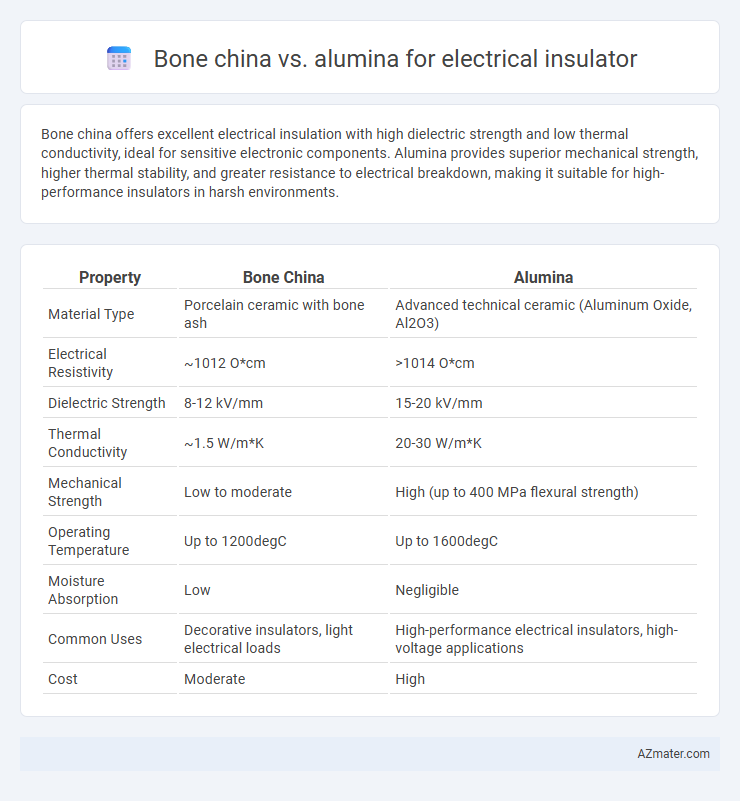Bone china offers excellent electrical insulation with high dielectric strength and low thermal conductivity, ideal for sensitive electronic components. Alumina provides superior mechanical strength, higher thermal stability, and greater resistance to electrical breakdown, making it suitable for high-performance insulators in harsh environments.
Table of Comparison
| Property | Bone China | Alumina |
|---|---|---|
| Material Type | Porcelain ceramic with bone ash | Advanced technical ceramic (Aluminum Oxide, Al2O3) |
| Electrical Resistivity | ~1012 O*cm | >1014 O*cm |
| Dielectric Strength | 8-12 kV/mm | 15-20 kV/mm |
| Thermal Conductivity | ~1.5 W/m*K | 20-30 W/m*K |
| Mechanical Strength | Low to moderate | High (up to 400 MPa flexural strength) |
| Operating Temperature | Up to 1200degC | Up to 1600degC |
| Moisture Absorption | Low | Negligible |
| Common Uses | Decorative insulators, light electrical loads | High-performance electrical insulators, high-voltage applications |
| Cost | Moderate | High |
Introduction to Electrical Insulators
Electrical insulators are essential materials that prevent unwanted flow of electric current, ensuring safety and efficiency in electrical systems. Bone china, a type of ceramic made from bone ash, offers excellent dielectric properties and mechanical strength, making it suitable for moderate voltage applications. Alumina, or aluminum oxide, exhibits superior electrical insulation, high thermal conductivity, and exceptional mechanical durability, making it the preferred choice for high-performance electrical insulators in demanding environments.
Overview of Bone China as an Insulator
Bone china is a ceramic material prized for its high mechanical strength, excellent dielectric properties, and resistance to thermal shock, making it a reliable electrical insulator in various applications. It contains bone ash, feldspathic material, and kaolin, resulting in low porosity and high insulation resistance under high voltage conditions. Compared to alumina, bone china offers superior electrical insulation in environments requiring a combination of mechanical durability and excellent dielectric performance.
Alumina Ceramics: Key Properties
Alumina ceramics exhibit exceptional electrical insulation properties due to their high dielectric strength and low electrical conductivity, making them ideal for demanding electrical insulator applications. Their superior thermal stability, wear resistance, and mechanical strength outperform bone china, which is more brittle and less durable under high-stress conditions. Alumina's ability to withstand high temperatures and corrosive environments ensures reliable performance in electrical components such as substrates, insulators, and spark plugs.
Mechanical Strength: Bone China vs Alumina
Alumina exhibits significantly higher mechanical strength compared to bone china, making it more suitable for demanding electrical insulator applications requiring durability and resistance to mechanical stress. Bone china, while offering good aesthetic qualities and moderate strength, lacks the fracture toughness and hardness of alumina, limiting its use in high-stress electrical environments. The high compressive strength of alumina, often exceeding 300 MPa, ensures superior performance in insulation where mechanical integrity is critical.
Dielectric Properties Comparison
Bone china exhibits a lower dielectric constant and higher dielectric strength compared to alumina, making it more effective at insulating electrical currents in low-frequency applications. Alumina offers superior thermal conductivity and higher dielectric breakdown voltage, which enhances performance in high-temperature and high-frequency electrical environments. The choice between bone china and alumina insulators depends on the specific dielectric property requirements, such as dielectric loss, permittivity, and mechanical robustness for the intended electrical insulation application.
Thermal Performance and Stability
Bone china exhibits excellent thermal stability and moderate thermal conductivity, making it suitable for electrical insulators that require consistent performance under fluctuating temperatures. Alumina, with its superior thermal conductivity and higher temperature resistance, provides enhanced thermal performance and stability for high-power electrical applications. The choice between bone china and alumina depends on the specific thermal management needs and operating temperature ranges of the electrical insulation system.
Manufacturing Processes for Both Materials
Bone china insulators undergo a complex manufacturing process involving the mixing of bone ash, kaolin, and feldspar, followed by shaping, drying, and firing at temperatures around 1200-1300degC to achieve high translucency and strength. Alumina insulators are produced through powder processing techniques, including calcination, pressing, and sintering at much higher temperatures near 1600-1700degC, resulting in dense, durable ceramics with superior electrical insulation and thermal conductivity. The manufacturing differences directly influence the physical properties and applications of each material in electrical insulation systems.
Longevity and Durability Factors
Bone china electrical insulators exhibit high mechanical strength and resistance to thermal shock but are generally less durable in harsh electrical environments compared to alumina insulators. Alumina insulators offer exceptional longevity due to their superior electrical insulation properties, high hardness, and excellent resistance to wear, corrosion, and high temperatures. The enhanced durability of alumina makes it more suitable for long-term applications in high-stress electrical systems where reliability and lifespan are critical.
Cost Analysis: Bone China vs Alumina
Bone china offers a lower initial material cost compared to alumina, making it a cost-effective option for low to medium-performance electrical insulators. Alumina, despite its higher expense, provides superior mechanical strength, thermal stability, and dielectric properties, resulting in longer lifespan and reduced maintenance costs over time. Evaluating the total cost of ownership reveals alumina as more economical for high-demand applications due to its durability and reliability benefits.
Applications and Industry Preferences
Bone china offers excellent electrical insulation properties with high mechanical strength and smooth surface finish, making it suitable for decorative electrical components and consumer electronics. Alumina provides superior thermal conductivity, electrical insulation, and resistance to wear and corrosion, widely preferred in heavy industrial applications such as power transmission, high-voltage insulators, and semiconductor manufacturing. Industries requiring high durability and thermal stability prioritize alumina, while bone china is favored in applications where aesthetic appeal combined with insulation is crucial.

Infographic: Bone china vs Alumina for Electrical insulator
 azmater.com
azmater.com